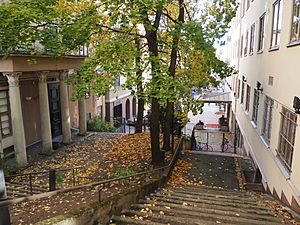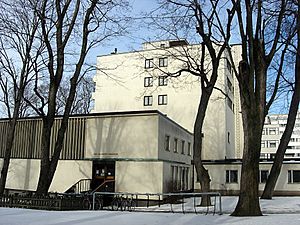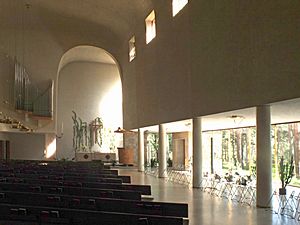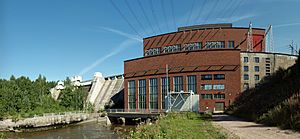Erik Bryggman facts for kids
Quick facts for kids
Erik Bryggman
|
|
|---|---|
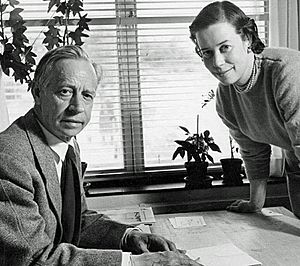
Erik and Carin Bryggman in the 1950s
|
|
| Born |
Erik Bryggman
7 February 1891 Turku, Finland
|
| Died | 21 December 1955 (aged 64) Turku, Finland
|
| Nationality | Finnish |
| Occupation | Architect |
| Spouse(s) | Agda Grönberg |
| Children | 3 |
| Awards | Finnish Association of Architects’ silver plaque |
| Buildings | Resurrection Chapel Atrium apartment building Restoration of Turku Castle |
| Projects | Varberg Crematorium, Sweden |
| Design | Turku Fair |
Erik William Bryggman (born February 7, 1891 – died December 21, 1955) was a famous Finnish architect. He was born in Turku, Finland. Erik started studying architecture in 1910 and became an architect in 1916. He traveled to Denmark, Sweden, and Italy to learn more about different building styles. In Italy, he was especially inspired by local, traditional buildings. In 1923, he opened his own architecture office in Turku. Erik Bryggman's buildings are special because they mix older Nordic styles with classic looks and modern designs.
Erik married Agda Grönberg in 1917. They had three children. Their daughter, Carin Bryggman (1920-1993), also became a well-known designer. She even finished some of her father's projects after he passed away in 1955.
Contents
Erik Bryggman's Architectural Journey
Erik Bryggman became well-known in Finland in the early 1920s. He designed many houses in a style called Nordic Classicism. This style used simple, classic shapes. Some of his most famous works from this time are in central Turku. These include the Hotel Seurahuone (1927–28) and the Atrium apartment building (1925–27). Right across from the Atrium building, he designed the Hospits Betel Hotel (1926–29). He also created a beautiful set of stairs and a small plaza between these two hotels. The Hospits Betel Hotel project showed how Bryggman started to move from classic styles to more modern ones. He removed some old-fashioned decorations and added a modern bell tower to a church that was part of the project.
Working with Alvar Aalto
In 1927, Bryggman started working with another important architect, Alvar Aalto. Together, they were pioneers in bringing modernist architecture to Finland. Their most famous joint project was designing the Turku Fair in 1929. This fair was a big event that showed off new ideas in building and design. It was seen as a step towards the very modern Stockholm Exhibition of 1930. Both architects visited Stockholm to get ideas. Historians have also noticed that both the Turku and Stockholm fairs were influenced by Russian Constructivist architecture, which focused on showing off the structure of buildings.
Later Works and Legacy
After Alvar Aalto moved to Helsinki in 1935, Bryggman continued his work alone. While he didn't become as famous as Aalto, he created many important buildings. Two of his most well-known individual projects are:
- The extension to the library of Åbo Akademi University in Turku (1935). This building shows a strict Functionalism style, meaning it was designed mainly for its purpose and usefulness.
- The Resurrection Chapel (1941) in the Turku cemetery. This chapel is considered a masterpiece. It blends Bryggman's architectural ideas with the natural landscape around it. Its design led to him being asked to design many war memorials and cemetery chapels after World War II.
Bryggman also worked on restoring the medieval Turku Castle from 1939 until he passed away. His assistant and his daughter, Carin Bryggman, continued this important work. He carefully repaired and even rebuilt parts of the castle. He also added some modern spaces inside the old castle.
Besides public buildings like hospitals, schools, and a power station, Bryggman designed several private homes and summer houses for wealthy clients in the Turku area. His only known project outside Finland was the Finnish pavilion at the Antwerp World Expo in Belgium (1929–30), which won a major award.
Notable Buildings by Erik Bryggman
Here are some of Erik Bryggman's key architectural works:
- Atrium apartment building, Turku (1925–27)
- Hospits Betel Hotel, Turku (1926–29)
- Hotel Seurahuone, Turku (1927–28)
- Turku Fair (1929), with Alvar Aalto
- Finnish pavilion, Antwerp World Expo, Belgium (1929–30)
- Pargas cemetery chapel (1930)
- Åbo Akademi University Library, Turku (1934–35)
- Resurrection Chapel, Turku (1938-1941)
- Harjavalta power station (1939)
- Restoration of Turku Castle (1939–55)
- Villa Staffans, Kakskerta (1945–1946)
- Honkanummi cemetery chapel, Vantaa (1952–55)
- Lohja cemetery chapel, Lohja (1952–56)
- Lappeenranta cemetery chapel, Lappeenranta (1955–56)
See also
 In Spanish: Erik Bryggman para niños
In Spanish: Erik Bryggman para niños
- Architecture of Finland


